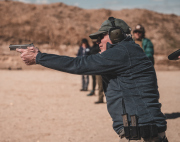For those of us who strongly prefer TDA's, and have put the time in to the system, the first DA pull is not a more difficult to shoot option, except by accident. When we want to shoot the gun, there is no downside.
Obviously, not everyone has that level of comfort or ability with the DA shot. That doesn't changes the benefits for those of us who do. (insert some American Express add here)




 Reply With Quote
Reply With Quote



